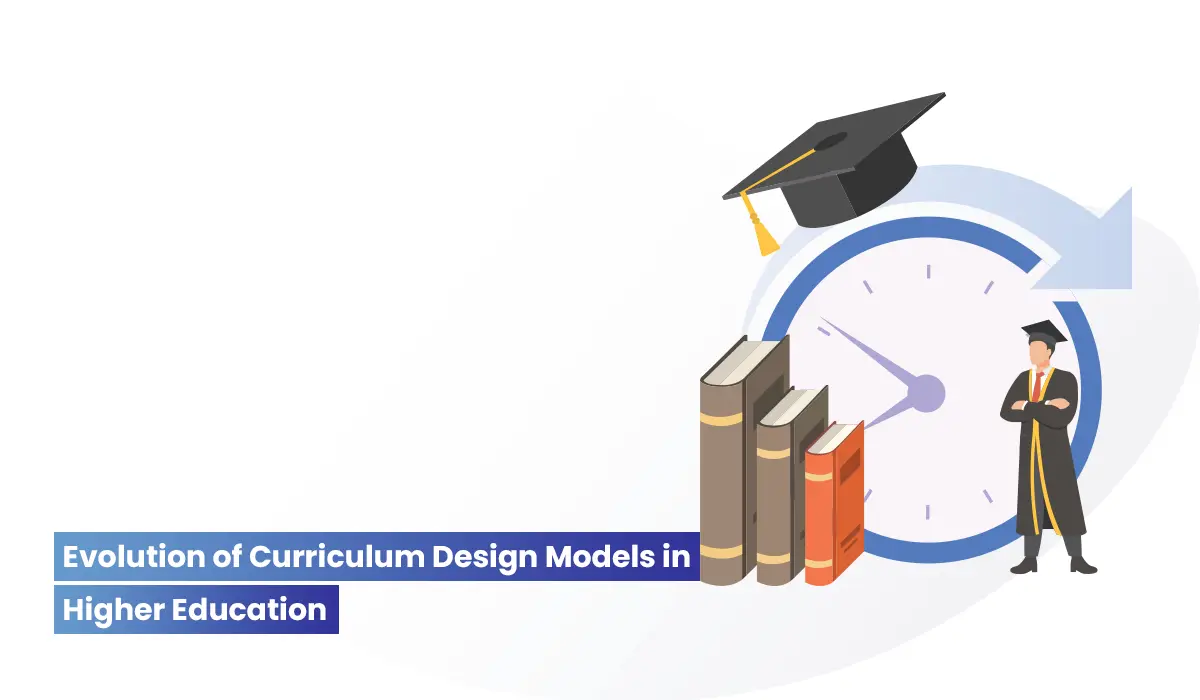According to a survey on higher education trends, 75% of colleges and universities are presently reassessing their models for designing curricula to be on par with their competitors, and to better meet the expectations of today’s students and industry standards. It is true that the frameworks that direct learning must change along with the environment of learning. This blog examines how innovative methods are rapidly replacing conventional curricular models, influencing the direction higher education takes before us.
Traditional Curriculum Design Models

Historically, educational programs have been organized using numerous philosophical and practical methods by use of traditional curriculum design frameworks. Typically, these models consist of:
Subject-Based Education: concentrates on particular fields or themes. places a focus on academic success and subject mastery.
Curriculum Focused on the Learner: There’s more emphasis on putting the needs, interests, and learning styles of the students first. stimulates student involvement and active learning.
Curriculum Driven by Knowledge: This sort of curriculum revolves around important ideas and concepts. encourages the application of information and in-depth comprehension.
Evolution Timeline of Traditional Curriculum Design Models

Challenges with Traditional Models

Even though they are fundamental, traditional curricular models have difficulties in addressing the demands of contemporary education.
Lack of and Restricted Flexibility: Having trouble adjusting to the varied requirements of students and changing trends in education.
Relevance: They were outdated. Faces challenges in keeping up with the quick changes in society and technology.
Engagement: Possibility of inactive learning environments with little student involvement.
Individualization: The difficulties of meeting the preferences and learning styles of each person.
Innovation: Innovative teaching approaches are impeded by a tendency to uphold established conventions.
Higher education must change its curriculum design strategies to become more adaptable, inclusive, and dynamic in order to meet these difficulties.
Emerging Trends in Curriculum Design

To fulfill the demands of contemporary education, curriculum design is changing and embracing cutting-edge strategies that make use of technology and put the needs of students first. The following are some significant new developments, especially as they relate to curriculum management software.
It is true certain that with the help of cutting-edge curriculum management software, these trends are going to revolutionize the way curricula are created, administered, and assessed, guaranteeing that education is effective, dynamic, and relevant in terms of preparing students for the future.
Education Based on Competencies (CBE)
Focus: Moves from a time-based learning approach to the mastery of certain talents and skills.
Software Support: By allowing the mapping of skills to courses, assignments, and assessments, curriculum management systems allow for the real-time tracking of student progress and mastery.
Interdisciplinary Approaches
Focus: Promotes interdisciplinary collaboration between those in the curriculum committee to address challenging, real-world issues.
Software Support: Enables project-based learning and seamless interdisciplinary course creation by facilitating various levels of curriculum mapping across several areas.
Technology Integration
Focus: Encourages integration of multiple disciplines to solve complex, real-world problems.
Software Support: Facilitates curriculum mapping across different subjects, allowing for seamless interdisciplinary course design and project-based learning.
Outcome-Based Education (OBE)
Focus: Stresses on achieving well-established learning objectives and goals.
Software support: Makes it possible to precisely plan out and build the curriculum in order to achieve these objectives, guaranteeing that assessments and course material are outcome-focused and on target.
Adaptive Learning Technologies
Focus: The use of adaptive learning technology is going to be a major curriculum design trend.
Software Support: It adapts diverse educational experiences to each student’s particular requirements and level of performance. Utilizing data analytics, software support modifies the pace and delivery of information to create customized curricula that increase student outcomes, achievement and engagement.
Real-Time Analytics and Reporting
Focus: The use of adaptive learning technology is poised to transform the field of curriculum design. To meet the individual requirements and performance levels of every student, they personalize learning experiences.
Software Support: By using data analytics, these technologies modify the pace and distribution of curriculum material, guaranteeing individualized learning experiences that maintain students’ attention and progress.
Intuitive Curriculum Design Tools
Focus: One of the biggest trends in education right now is streamlining curriculum management with a set of intuitive tools. It makes planning, developing, administering, and the whole approval process of the curriculum easier.
Software Support: Maintains coherence and consistency across the educational program by using user-friendly interfaces to build and map courses in accordance with competence frameworks.
Project-Based Learning
Focus: One of the main pillars of the next educational trends is project-based learning. Through intensive projects, it places a strong emphasis on practical, experience learning.
Software Support: Promotes cooperation and creates positive feedback loops by enabling the smooth monitoring, organizing, and evaluation of student work.
Case Studies of Innovative Curriculum Models
Empowering Dental Education: A Success Story with DDUH in Ireland
Client Profile
- Institution: Dublin Dental University Hospital (DDUH)
- Specialization: National Center of Excellence in Education, Research, and Patient Care in Ireland
DDUH Institutional Gap and Creatrix Solutions
- Challenge: DDUH faced challenges in manually calculating outcomes attainment and student outcomes.
- Solution: Creatrix delivered a tailored OBE solution for efficient curriculum mapping and outcomes tracking.
How Creatrix Campus’s Curriculum Management Helped
- Provided an intuitive OBE-rich curriculum management solution with easy-to-use workflows and robust coordination tools.
- Automated, simplified, and streamlined curriculum tasks for clearer visibility and effective teaching.
- Identified and addressed academic gaps, redundancies, and misalignments with Visual Curriculum Design.
- Offered a visual display of the complete program’s mapping for easy progress measurement using the Curriculum Mapping Tree.
- Enabled individual access for mapping operations and provided insightful reporting tools.
- Streamlined faculty tasks, reducing administrative overhead.
Business Outcomes
- Exceeded Expectations: Delivered features and functionality at no extra cost and with no additional implementation time.
- Cloud-Native, Low-Code Integration: Automated OBE-based curriculum management.
- Clear Student Operations: Provided an audit log for transparent views.
- Reduced Implementation Time: Halved the time needed.
- Streamlined Onboarding: Lowered administrative overhead.
- Driving Excellence: Established an Integration Center of Excellence.
Conclusion: Overcoming Challenges with Creatrix Campus Innovative Curriculum Design Software
Without a doubt, curriculum design in higher education is ever-evolving, and Creatrix Campus provides a sweeping solution that turns traditional curriculum management into a streamlined, data-driven process that addresses critical challenges and promotes excellence.
Why Opt for Creatrix Campus?
Simplified Procedure: Get rid of the confusion caused by PDFs and email threads. Our low-code platform’s user-friendly, aesthetically pleasing features expedite curriculum administration.
Competency- and outcome-based Planning: Using strong online teaching resources and assessment techniques, create a comprehensive curriculum that is outcome- and competency-based and satisfies industry standards.
Live Mapping and Analysis: Provide your curriculum committee with up-to-date information in real-time and a central center so that all parties may work together easily.
Continuous Improvement: To ensure continuing improvement and the success of your students, make use of a thorough curriculum analysis.
Accreditation Reports: Get up-to-date accreditation information through thorough reports.
Visual Curriculum Mapping Tools: Using a clear picture of course and program accomplishment, Visual Curriculum Mapping puts the focus on results.
Start the process of transforming the curriculum design at your school. Get a customized product brochure from Creatrix Campus and discover the curriculum management of the future now.
#Evolution #Curriculum #Design #Models #Higher #Education










